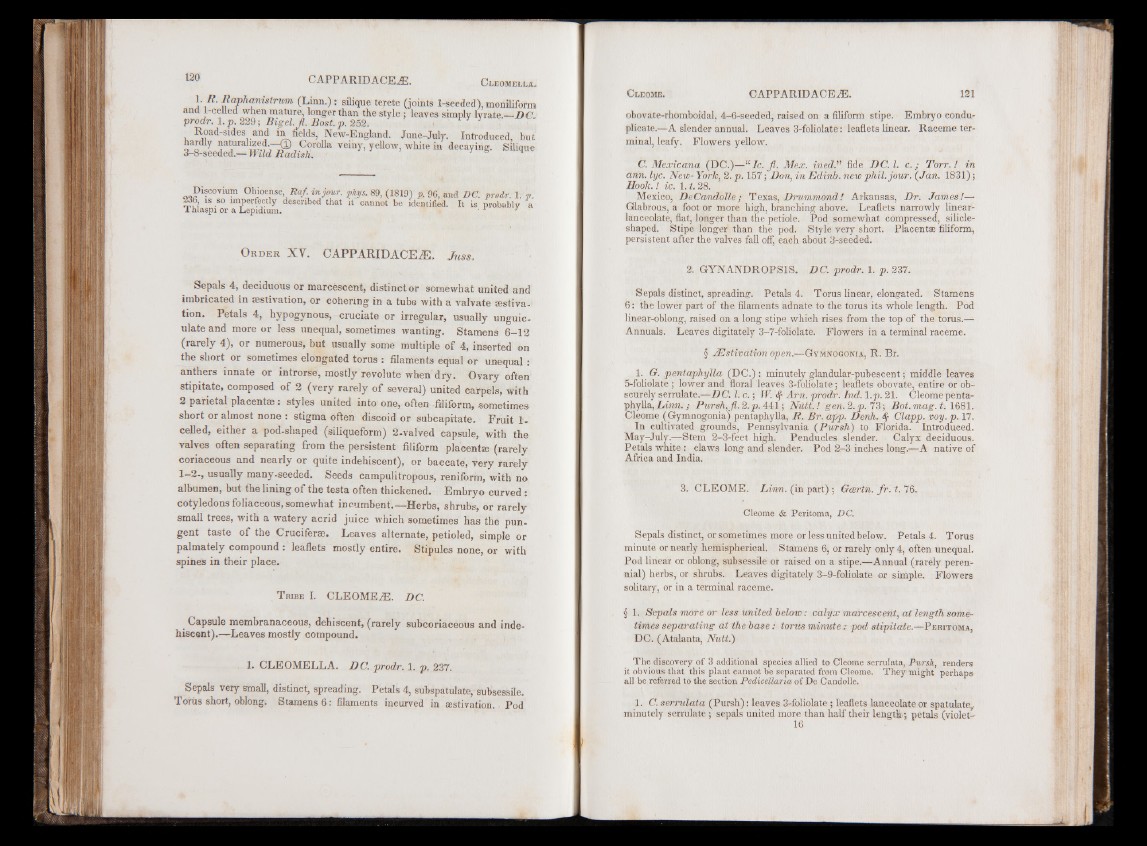
1. R. Raphanistrum (Linn.): silique terete (joints 1-seeded), moniliform
and 1-eelled when mature, longer than the style ; leaves simply lyrate.—DC.
prodr. l.p . 229; Bigel.Jl. Bost.p. 252.
Road-sides and in fields, New-England. June-July. Introduced, but
hardly naturalized.—(J) Corolla veiny; yellow, white in decaying. Silique
3-8-seeded.— Wild Radish.
DiscOTium Ohioense, Raf. in jour. phys. 89, (1819) p. 96, and DC. prodr. 1. v.
236, is so imperfectly described that it cannot be identified. It is probably a
1 maspi or a Lepidium. * r J
Or d e r XY. CAPPARIDACEÆ. Juss.
Sepals 4, deciduous or marcèscent, distinct or somewhat united and
imbricated in aestivation, or cohering in a tube with a valvate æstiva-
tion. Petals 4, hypogynous, cruciate or irregular, usually unguic-
ulate and more or less unequal, sometimes wanting. Stamens 6-12
(rarely 4), or numerous, but usually some multiple of 4, inserted on
the short or sometimes elongated torus : filaments equal or unequal :
anthers innate or introrse, mostly revolute when dry. Ovary often
stipitate, composed of 2 (very rarely of several) united carpels, with
2 parietal placentae : styles united into one, often filiform, sometimes
short or almost none : stigma often discoid or subcapitate. Fruit 1-
celled, either a pod-shaped (siliqueform) 2-valved capsule, with the
valves often separating from the persistent filiform placentae (rarely
coriaceous and nearly or quite indéhiscent), or baccate, very rarely
1-2-, usually many-seeded. Seeds campulitropous, reniform, with no
albumen, but the lining o f the testa often thickened. Embryo curved :
cotyledons foliaceous, somewhat incumbent.—Herbs, shrubs, or rarely
small trees, with a watery acrid juice which sometimes has the pungent
taste of the Crucifer*. Leaves alternate, petioled, simple or
palmately compound : leaflets mostly entire. Stipules none, or with
spines in their place.
T ribe I. CLEOMEÆ. DC.
Capsule membranaceous, dehiscent, (rarely subcoriaceous and indéhiscent).—
Leaves mostly compound.
1. CLEOMELLA. DC. prodr. 1. p. 237.
Sepals very small, distinct, spreading. Petals 4, subspatulate, subsessile.
Torus short, oblong. Stamens 6 : filaments incurved in aestivation. Pod
obovate-rhomboidal, 4-6-seeded, raised on a filiform stipe. Embryo condu-
plicate.—A slender annual. Leaves 3-foliolate: leaflets linear. Raceme terminal,
leafy. Flowers yellow.
C. Mexicana (DC.)—“ 7c. Ji. Mex. ined.” fide DC.l. c .; Torr. ! in
ahn. lyc. New- York, 2. p. 157; Don, in Edinb. new phil.jour. (Jan. 1831);
Hook.! ic. 1 .1.28.
Mexico, DeCandolle; Texas, Drummond! Arkansas, Dr. James!—
Glabrous, a foot or more high, branching above. Leaflets narrowly linear-
lanceolate, flat, longer than the petiole. Pod somewhat compressed, silicle-
shaped. Stipe longer than the pod. Style very short. Placentae filiform,
persistent after the valves fall off, each about 3-seeded.
2. GYNANDROPSIS. DC. prodr. 1. p. 237.
Sepals distinct, spreading. Petals 4. Torus linear, elongated. Stamens
6 : the lower part of the filaments adnate to the torus its whole length. Pod
linear-oblong, raised on a long stipe which rises from the top of the torus.—-
Annuals. Leaves digitately 3-7-foliolate. Flowers in a terminal raceme.
§ 2'Estivation open.—Gymnogonia, R. Br.
1. G. pentaphylla (DC.): minutely glandular-pubescent; middle leaves
5-foliolate ; lower and floral leaves 3-foliolate; leaflets obovate, entire or obscurely
serrulate.—DC. 1. c .; IV. § Am. prodr. Ind. l.p. 21. Cleome pentaphylla,
L in n .; Pursh, fl. 2.p. 441; Nutt.! gen. 2. p. 73; Bot.mag.t. 1681.
Cleome (Gymnogonia) pentaphylla, R. Br. app. Denh. <f Clapp, voy. p. 17.
In cultivated grounds, Pennsylvania (Pursh) to Florida. Introduced.
May-July.—Stem 2-3-feet high. Penducles slender. Calyx deciduous.
Petals white : claws long and slender. Pod 2-3 inches long.—A native of
Africa and India.
3. CLEOME. Linn, (in part) ; Gcertn. f r . t. 76.
Cleome & Peritoma, DC.
Sepals distinct, or sometimes more or less united below. Petals 4. Torus
minute or nearly hemispherical. Stamens 6, or rarely only 4, often unequal.
Pod linear or oblong, subsessile or raised on a stipe.—Annual (rarely perennial)
herbs, or shrubs. Leaves digitately 3-9-foliolate or simple. Flowers
solitary, or in a terminal raceme.
§ 1. Sepals more or less united below: calyx marcescent, a t length sometimes
separating at the base: fonts m in u te p o d stipitate.—P eritoma,
DC. (Atalanta, Nutt.)
The discovery of 3 additional species allied to Cleome serrulata, Pursh, renders
it obvious that this plant cannot be separated from Cleome. They might perhaps-
all be referred to the section Pedicellaria of De Candolle.
1. C. serrulata (Pursh): leaves 3-foliolate ; leaflets lanceolate or spatulate.
minutely serrulate ; sepals united more than half their length; petals (violet-
16